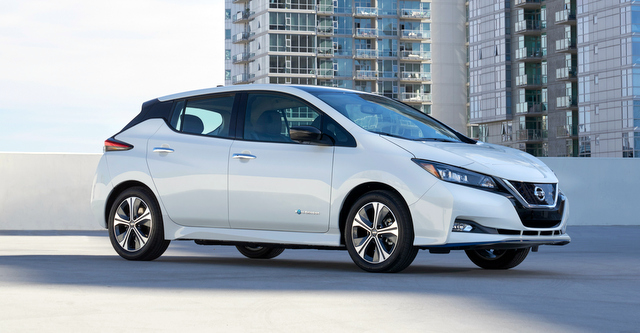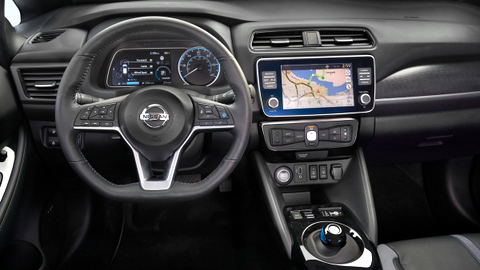EV Pioneer Is Competitive Again
The Nissan Leaf is a true pioneer—the car that brought all-electric vehicles mainstream when it was introduced in 2010 as an 2011 model. It’s the best-selling EV ever (for now), with nearly 400,000 sold worldwide (130,000+ in the U.S.).

However, as competitors appeared, the venerable Leaf showed its largest flaw—lack of range. The 2018 model partially remedied that with a larger 40-kilowatt-hour (kWh) lithium-ion battery that pushed range up to 150 miles, but it wasn’t until the 2019 Nissan Leaf Plus arrived that the Chevrolet, Hyundai, Kia, Tesla and other EVs got real competition.
The 2019 Nissan Leaf Plus boasts a new 62-kWh battery, with up to 226 miles of range in the base S Plus model. Its larger 160-kilowatt (kW) motor produces 214 horsepower and 250 pounds-feet of torque—a 45 percent improvement—and good for 50-75 mph sprint that’s nearly 13 percent faster.

The new higher-density battery is virtually the same size as the older, less powerful one, so passenger and cargo capacity are unaffected. You can carry 23.6 cubic feet of stuff with ease.
Features That Stand Out
Two features stand out in the new models. One is Pro-Pilot, which combines adaptive cruise control with a lane-positioning feature. While not actual autonomy, it does make long trips easier and is a starting point for the true autonomous cars of the future.

The other exciting tech feature is e-Pedal. It provides regenerative braking to not only charge the battery, but slow down, too, just by lifting your foot off the accelerator. The Leaf can slow down to almost a complete stop with just one pedal. Once you get used to this, you’ll never go back.
The Leaf Plus comes in three levels—S, SV, and SL. All are mechanically the same; with each trim level the feature list grows longer as the price rises.
The S model gets slightly better range—226 miles vs. 216—likely due to lower weight. The SV Plus adds 17-inch alloy wheels, fog lights, a heated steering wheel, NissanConnect with Navigation and smart-phone connections (Apple CarPlay and Android Auto), upgraded audio and some of Nissan’s Intelligent Mobility technology.
The SL brings in LED headlights and daytime running lights, heated outside mirrors with integrated turn signals, leather-appointed seats, an eight-way power driver’s seat, and Bose premium seven-speaker audio. You also get a host of the worthwhile safety features, including blind spot warning, rear cross traffic alert, the Intelligent Around View Monitor and more.
Second Generation Style
The new Leaf, introduced as a 2018 model, gave the car a thorough style update inside and out, while retaining the same basic structure. You can see carryover pieces in the unique windshield pillars and interior door panels, but the front and rear body sections and the rest of the interior are brought stunningly up to date. The new dash, part of the “gliding wing” design language, offers a larger 8.0-inch center screen with all the easy-to-use features of a smart phone.

The first-gen Leaf’s styling was meant to stand out, but today’s car is a bit more angular and wears the corporate V-Motion grille, with blue 3D mesh (blue means “clean” in car design language, not green). The taillamps are now horizontal, creating a harder edge compared to the softly integrated vertical ones in gen one. The odd headlamps are swapped for more conventional units.
My test car, an SL Plus, wore optional white and black two-tone paint ($695). Kick plates ($130) were the only other option. The sticker, with shipping, came to $44,270. As a result of its sales success, the Leaf no longer qualifies for the full $7,500 Federal tax break, but legislation hopefully will extend that program. Base S Plus models start at $37,445, including shipping, while the base Leaf S starts at just $29,990 plus shipping.
The Competition
You may ask why Nissan didn’t just replace the 40 kWh-battery, 150-mile-range standard Leaf with the new one. The answer is contained in the above paragraph. Since 150 miles is plenty of range for most people, the standard Leaf offers a significantly less expensive EV choice compared to other EVs—by thousands of dollars. With remaining tax breaks and rebates, it can become a very affordable way to go electric.

The new Leaf feels smooth and powerful. Its seats are more comfortable than the ones in the Bolt EV. Quality is high, offering a near-luxury ambiance found in cars like the Jaguar I-Pace. I was surprised that my top-level Leaf Plus didn’t have a telescoping steering wheel, but otherwise it felt loaded.
However, things are changing fast in the world of electric transportation. With the Leaf Plus, Nissan is keeping up with the competitors, but not surpassing them. It’ll be interesting to see what the pioneer brings out for its next act—a EV crossover, perhaps?
Related Stories You Might Enjoy—The Long-Range EV Competition
Clean Fleet Report has looked at the 2019 Nissan Leaf Plus before—by taking it on an almost 500-mile to challenge its long-distance potential. Those miles are recounted here.
Road Test: 2019 Chevrolet Bolt EV
Road Test: 2019 Kia Niro EV (John’s view)
Road Test: 2019 Kia Niro EV (Gary’s view)
Road Test: 2019 Kia Niro EV (Steve’s view)
Road Test: 2019 Hyundai Kona EV (Gary’s view)
Road Test: 2019 Hyundai Kona EV (Steve’s view)
Flash Drive: Tesla Model 3
Make sure to opt-in to the Clean Fleet Report newsletter (top right of page) to be notified of all new stories and vehicle reviews.
Disclosure:
Clean Fleet Report is loaned free test vehicles from automakers to evaluate, typically for a week at a time. Our road tests are based on this one-week drive of a new vehicle. Because of this we don’t address issues such as long-term reliability or total cost of ownership. In addition, we are often invited to manufacturer events highlighting new vehicles or technology. As part of these events we may be offered free transportation, lodging or meals. We do our best to present our unvarnished evaluations of vehicles and news irrespective of these inducements.
Our focus is on vehicles that offer the best fuel economy in their class, which leads us to emphasize electric cars, plug-in hybrids, hybrids and diesels. We also feature those efficient gas-powered vehicles that are among the top mpg vehicles in their class. In addition, we aim to offer reviews and news on advanced technology and the alternative fuel vehicle market. We welcome any feedback from vehicle owners and are dedicated to providing a forum for alternative viewpoints. Please let us know your views at publisher@cleanfleetreport.com.

5 thoughts on “Road Test: 2019 Nissan Leaf Plus 62 kWh”